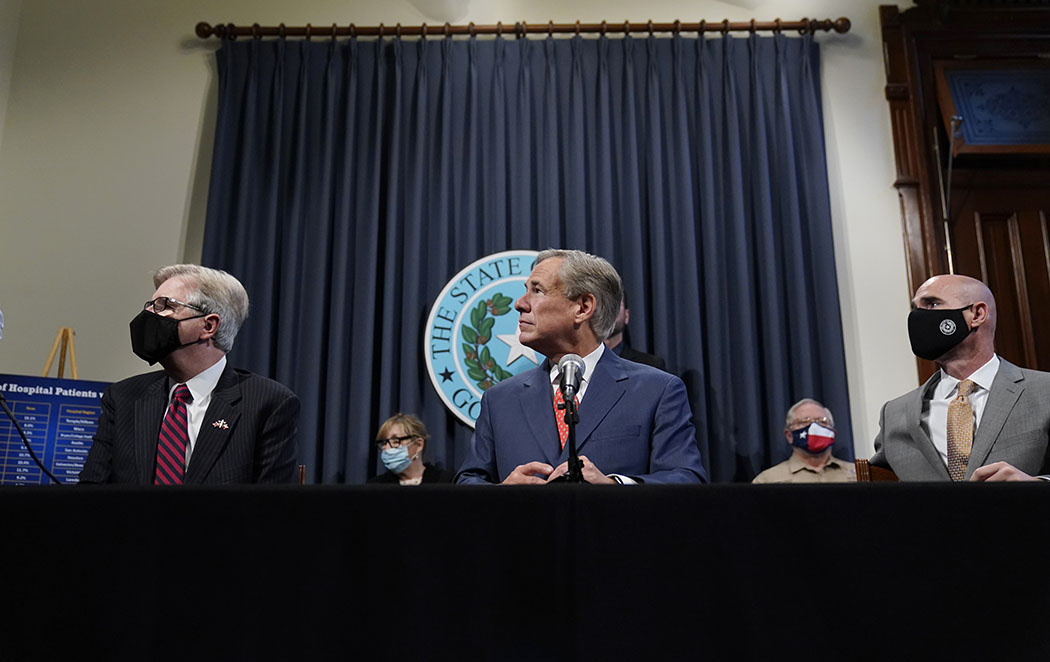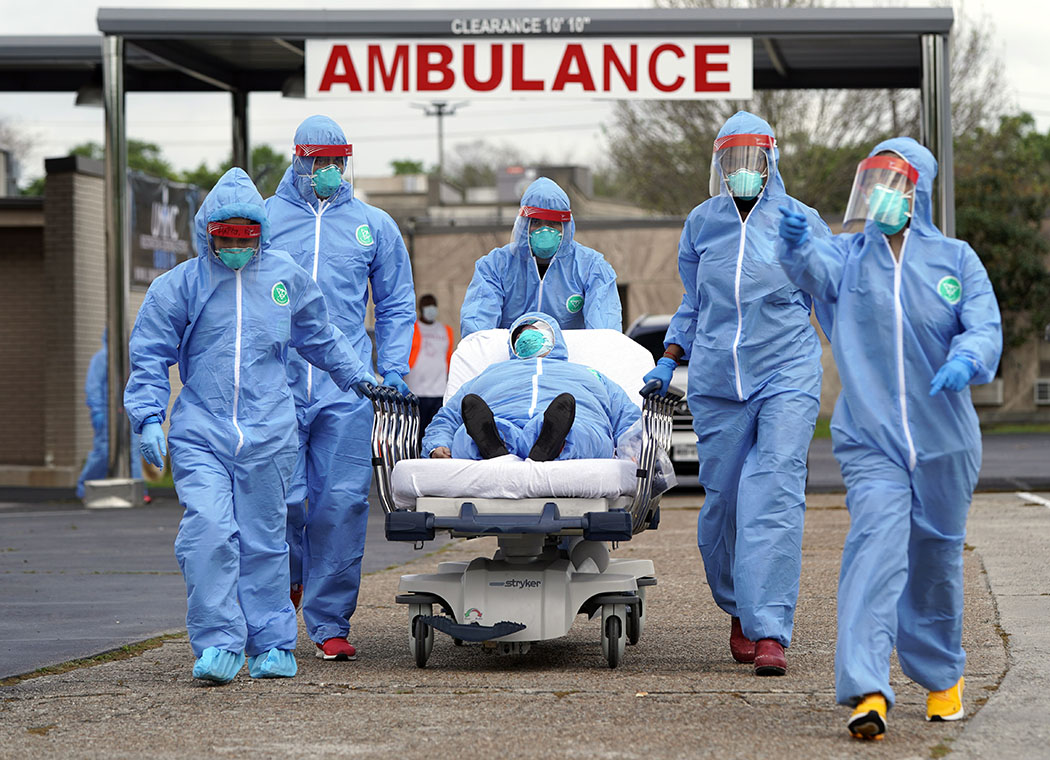
Texas’ health system has been underfunded, understaffed, and unprepared for years. Here, COVID-19 found the perfect place to spread.
By Sophie Novack
November 9, 2020
The room was packed, the shutters drawn against the Austin heat. It was September 17 and Texas state leaders took to one of the smallest rooms in the Capitol building for a press conference on the coronavirus. They filed in that afternoon and took their seats: Lieutenant Governor Dan Patrick and House Speaker Dennis Bonnen on either end of a rectangular table, Governor Greg Abbott between them. Each wore a black mask and sat a foot or so apart. State health officials took their seats against the wall behind them, partially hidden from view.
Abbott removed his mask to speak, revealing a slight grin. This was a happier occasion for the governor than his announcement just two and a half months earlier, when after weeks of surging hospitalizations, he had reluctantly heeded the advice of public health officials and scaled back the state’s spring reopening. Now, inside the cramped conference room, he was here to announce a win. COVID-19 hospitalizations were at their lowest levels since July, he said, and “the number of people recovering from COVID continues to skyrocket.” So Abbott, a Republican, had an announcement: Most businesses, with the exception of bars, could open to 75 percent capacity. Visits could resume in some nursing homes for the first time since March. “Texans have shown that we can address both the health and safety concerns of COVID while also taking carefully measured steps to restore the livelihoods that Texans desperately need,” he said.
But the governor’s pronouncement ignored some harsh realities. New infections, while no longer spiking, were still about triple what they were when Abbott first reopened the state in May. Hospitalizations were down since their peak in July but had plateaued at a level double what they were this spring. By mid-September, more than 15,600 Texans had died. Meanwhile, scientists warned of new spikes in the midst of flu season and schools reopening.
More than seven months into the pandemic, Abbott and other state leaders have merely paid lip service to the idea of balancing public health and the state’s economy. Experts say Texas is still not testing enough people to have an accurate and timely understanding of the virus’ spread. The state’s COVID-19 data is inconsistent and unreliable, partially because the state’s antiquated data system has caused backlogs in reporting case information. Local officials are still struggling to keep up with case investigations, and with about 3,700 contact tracers as of early September, the state has not met Abbott’s own modest goal of 4,000 by this spring.
In Texas, COVID-19 found the perfect place to spread.

A conservative Texan brand of individualism has long guided our health policy, from lawmakers backing a fast-growing anti-vaccine movement, to a continued rejection of Medicaid expansion, to a Texas-led lawsuit before the U.S. Supreme Court in November that seeks to eliminate the Affordable Care Act, amid a global pandemic, without any replacement plan. Our pandemic strategy has mirrored this approach: Each person for themselves. Wait for crises to crop up instead of taking steps to prevent them. Cut assistance at the first sign it’s helping. Hold our breath and hope for the best.
The state’s public health system has been underfunded and overstretched for years. Texas spent just $17 per person on public health in 2019, less than all but 10 other states. The state budgeted $17.7 million for infectious disease surveillance, prevention, and epidemiology this year. By contrast, we budgeted more than $400 million—23 times as much—on border security. Instead of investing state dollars, lawmakers have largely funded public health through federal grants that have been subject to dramatic cuts for more than a decade.
“We just didn’t have the infrastructure in place to scale up a public health response; public health departments have been so dramatically underfunded for so long,” says Ben King, an epidemiologist and professor at the University of Houston College of Medicine. It’s simply not a legislative priority. “Nobody gets fired up and says, ‘Yes, let’s build up our public health department!’” he says. “But what we’re seeing is, fundamentally, that undermining and defunding public health has this outcome.”
For all the shortcomings COVID-19 has exposed in the U.S. health system, the failures are especially pronounced in Texas. The Lone Star State has the highest rate and number of uninsured residents, by far. More rural hospitals have shuttered here in the last decade than in any other state. More than one-fifth of Texas’ 254 counties have only one doctor or none at all. Racial disparities in health are pronounced and often ignored by lawmakers. Nursing homes, where the virus has proved especially deadly, are dangerously understaffed and underregulated; the same can be said of prisons.
COVID-19 has laid bare the ways chronic underfunding impairs basic public health functions on a day-to-day basis, from outdated computer systems to low pay and persistent employee turnover, says a state epidemiologist who did not want their name included. “There’s consistent turbulence and no stability and no ability to actually plan ahead or get ahead on this type of thing because we’re in a chaotic free fall just trying to do our regular work,” they told me. “Everybody was already making do to do their regular jobs, much less when a fucking pandemic comes.”
Health departments in Texas are “understaffed at every level,” says Marilyn Felkner, a professor at the University of Texas at Austin and former manager of the emerging and acute infectious disease branch at Texas’ Department of State Health Services (DSHS). “It’s difficult to measure the diseases that didn’t happen, and that’s what public health is all about: trying to make sure diseases don’t happen,” she says. “That’s kind of the problem that you’re up against in public health, is that unless you’re in the middle of crises, people don’t really see that as a high priority.”
*
Early this spring, Ron Cook, a doctor and the city of Lubbock’s health authority, needed to secure personal protective equipment (PPE) for hospital workers in the West Texas city of 250,000. But when he started searching, he found that state and national supplies of PPE had been severely depleted. Then Cook had an idea: He called up his college roommate, an engineer at a plastics corporation, to see if he had materials to make protective face shields. Two 400-pound rolls of plastic soon arrived, and volunteers got to work cutting them up. Cook, who is also chief health officer for Texas Tech University’s medical school, asked the university’s engineering department to 3D-print headbands to hold up the plastic shields.
“We started pulling stuff together: ‘Hey, can you test this?’ and, ‘Can you make this?’” Cook says. “We’re kind of used to, out here in West Texas, pulling in things from all kinds of different directions to make things work.” In late September, Cook warned that cases were surging again in Lubbock, hospital ICUs were filling up, and the virus was spreading in schools and college campuses. The city struggled to keep up.
The city of Lubbock health department is one of about 70 county and city health departments scattered across Texas that are responsible for managing public health in their jurisdictions. In major metro areas, the departments sometimes have hundreds of employees and multimillion-dollar budgets; smaller, rural health departments may comprise a food inspector and not much else. The nearly 200 counties that don’t have their own health department rely on DSHS regional offices, which divide Texas into eight sections—each larger than many U.S. states—and cover more than 15 percent of the state’s population. In the Texas Panhandle, for instance, the regional department covers an area of nearly 35,000 square miles.
On average, regional health departments in Texas spent about $11.50 per capita in the last fiscal year and have one employee (including administrative workers) for every 5,260 Texans they serve, according to an Observer analysis of DSHS data. Regional and local health departments can tap the state health department in Austin for help, but that too is chronically underfunded and understaffed.
This scattered approach to public health in Texas isn’t new. In the 19th century, in response to epidemics that regularly wiped out large swaths of urban populations, local interventions cropped up absent a state health agency. Galveston issued the state’s first quarantine regulations in 1850 in response to a spate of yellow fever epidemics. Quarantines soon spread along the Gulf Coast to try to stem yellow fever and smallpox. The Texas Quarantine Department, DSHS’s predecessor, was created in 1879. At first the department’s work was mainly confined to managing quarantines because it lacked funds to address the myriad other health issues plaguing the state, according to the Texas State Historical Association. Staff was sparse and their office “consisted of one dark and poorly ventilated room in the Capitol.” By the second half of the 20th century, about as many local health departments existed as do today, but they didn’t cover much of the state. So the Legislature began funding regional health departments in 1970 to fill in the gaps.
In 1999, Texas became one of the first states to pass a law that established essential local public health services. But the requirements came with a major caveat: “subject to the availability of funds.” Since then, local health departments have faced budget cuts and struggled to attract workers, particularly to rural areas. Fifteen years later, the Sunset Commission, which reviews and issues recommendations on state agencies, wrote that Texas’ public health structure “presents numerous challenges that ultimately leave core services to the mercy of local economies and politics.”
For example, in 2011, the city of Lubbock, in an effort to save money, nearly eliminated its health department. The plan was to keep one health worker tasked with disease surveillance and outsource the rest of the required services, according to the Lubbock Avalanche-Journal. Only after public outcry and a conveniently timed hepatitis A scare at a local restaurant did city officials change course. But budget cuts over the next couple years left the local health department anemic anyway. Any loss of local public health services pushed the responsibility to the state via the DSHS regional office, says David Lakey, then Texas health commissioner. But the agency wasn’t provided extra money to provide services, like contact tracing for sexually transmitted diseases in the city with one of the highest STD rates in the state.
In a warning that feels especially relevant now, the Sunset Commission wrote that “the stretched resources could delay the amount of time needed to conduct contact investigations, putting more people at risk.”
Meanwhile, regular reconfigurations of the state health department in Austin made it less responsive, says Lakey, whose tenure as commissioner from 2007 to 2015 was bookmarked by two major reorganizations of the agency. These “take a lot of time and effort from the agency staff,” he says, and “can be a distraction on focusing on your core mission in the midst of an event like this.”
A committee of public health experts tasked with reporting recommendations to top state officials each year has repeatedly found that the state hasn’t adequately protected Texans’ health. In its first report in 2013 and in the most recent in 2019, the committee came to the same scorching conclusion: “The Texas public health system is fragmented, complex, and in some instances, non-existent.”
That’s a big reason why the state has repeatedly failed to implement lessons from other disease outbreaks like H1N1 or Ebola. A 2015 bill authored by state Senator Charles Schwertner, a Georgetown Republican, would have centralized authority in responding to infectious disease emergencies and funded a stockpile of PPE. But it stalled in the House. Local officials and public health experts generally favor a system of local control, because they say those leaders better know the needs of their communities. But that theoretical advantage has been hamstrung by mixed messaging from government officials and a persistent lack of support and resources.
DSHS did not respond to interview requests for this story or emailed questions from the Observer. Agency officials have cited funding cuts as impeding the COVID-19 response, and before the pandemic warned that the state’s data system was outdated and at times dysfunctional.
In mid-April, more than a month after the coronavirus had descended on Texas, the state health department sent an email to Austin-area employees about wearing masks at work. The city had recently mandated that residents wear face coverings outside their homes, but the agency tasked with managing Texas’ coronavirus response wanted its employees to know the rule didn’t apply to them. “Team members can wear a face covering while in the office if they choose to do so,” the message read. Most employees were working from home, but some would soon need to come gather their things and bring them to a new office—a long-planned move after a mold infestation in 2018 forced more than 125 employees from one agency building.
DSHS sent another email on July 21, stating that masks would be required for agency staff, citing Abbott’s statewide mask mandate announced earlier that month. “It’s ridiculous,” says the DSHS epidemiologist of the department’s waffling. “We should be ahead of the curve, setting the tone.”
*
Since March, local officials have taken the lead on pushing COVID-19 protections in their jurisdictions, which has put them in constant conflict with Abbott. In mid-April, the governor created his Strike Force to Open Texas, partly composed of restaurateurs and retail magnates who have donated large sums to his reelection campaign.
Soon after, the governor stripped local authority to issue stay-at-home orders or mask mandates, instead issuing his own statewide rules on reopening—a move that Dallas County Judge Clay Jenkins, who issued the state’s first stay-at-home order in March and who led the county’s Ebola response in 2014, called an “unprecedented state usurpation of local control.” Places that had so far kept their infections contained, from Houston to rural Starr County on the Texas-Mexico border, saw their hospitalizations surge out of control, as local officials pleaded with the governor to once again allow them to issue restrictions. By the early summer, Texas had one of the worst outbreaks in the country. In mid-June, Bexar County Judge Nelson Wolff tried a different tack, issuing an order that masks must be worn in businesses. Surprisingly, it worked. Later that day, Abbott said that Wolff had “finally figured out” his COVID-19 riddle: Local governments couldn’t mandate that individuals wear masks, but they could mandate that businesses mandate that individuals wear masks.
In the month and a half between Abbott striking down local orders and Wolff discovering a solution, more than 70,000 Texans tested positive for COVID-19, and more than 1,400 died.
Throughout June, Abbott equivocated. He relented and shut down bars in late June, and issued a statewide mask requirement on July 2. Through it all, local officials were still primarily responsible for keeping their communities safe, and without clear guidance from Abbott and other state leaders, the result was a dramatically different pandemic response depending on location. (The governor’s office did not respond to questions from the Observer.)
Harris County, one of the counties hit hardest by COVID-19, increased workers focused on epidemiology from 25 to 500 in just a few months, says Umair Shah, head of the county health department. In the Rio Grande Valley’s Cameron County, where the virus has ravaged communities, Esmer Guajardo, the health administrator, has had to ask employees to stay after hours to respond to COVID-19. The county can’t afford to buy software to expedite the process, so workers gather scattered case reports sent via email or fax from hospitals and doctors offices, scouring them for duplicates. Other health departments have recruited university students and volunteers to help keep up with contact tracing. To bypass what local officials say is a jumbled chain of communication to report test results, Cook asked every testing site in Lubbock, including Walmart and CVS, to send results directly to the city health department as well as the state. That way he doesn’t have to wait for the test to go to Austin, then “loop back around to us.”
In rural areas without their own local health departments, county officials often had to fill in for overwhelmed regional health departments. In Sherman County, at the top of the Panhandle bordering Oklahoma, the ambulance director took over contact tracing. In Donley County, east of Lubbock, the town’s only medical doctor, John Howard, is also the county judge—so when patients test positive in his clinic, he calls to tell them to quarantine and ask about their contacts himself. But in some Northeast Texas counties, contact tracing didn’t appear to be happening at all this spring because DSHS officials wouldn’t share the names of infected people with county leaders. In Red River County, an hour west of Texarkana, the county judge only found out who the first positive case was because his wife posted about it on Facebook. In Sabine County, at the Texas-Louisiana line, the judge said he learned of the county’s first case from a state trooper who was told by the person as they crossed the border.
As infections surged to their highest rates this summer, contact tracing couldn’t keep pace with the reopening of businesses and the spread of the virus. “The system was so overwhelmed. It was being run by volunteers. It’s just crazy,” says King, the epidemiologist in Houston. The breakdown in contact tracing was exacerbated by Texas’ persistent delays in testing, with lab results taking up to two weeks in many areas this summer. “You’re losing data, losing information; you’re also losing the time that those contacts may be infectious in the community,” King says. “Not only can they not recall who their contacts were 14 days earlier, [but] as we reopen the economy, there are more sort of tangential contacts, which become impossible to trace.”
Across Texas, efforts to test and trace positive cases have been further stymied by archaic, glitchy technology and convoluted reporting systems that have led to late course corrections and data dumps of weeks-old cases. In August, the statewide positivity rate skyrocketed to nearly 25 percent, then plummeted—swings the state health department later attributed to an addition of thousands of backlogged cases from earlier in the summer. DSHS has since changed the way it reports the state’s positivity rate, from counting cases on the day they were reported to counting them on the day they were tested. This has smoothed some of the peaks and valleys but means the new rate reported each day is lower than it will ultimately be. The discrepancies moved Collin County to add a warning to its COVID-19 tracker, saying it “lacks confidence” in the data.
*
One morning in late April, John Henderson, CEO of the Texas Organization of Rural and Community Hospitals, loaded a few hundred gallons of hand sanitizer donated by an Austin distillery into the back of a rented pickup and set off toward Abilene, three and a half hours northwest. There he met up with his dad, a recently retired rural hospital physician. The elder Henderson took the supplies to Moore County, near Amarillo, where a COVID-19 outbreak at the beef slaughterhouse had overtaken the rural county of about 21,000 and its 25-bed hospital. For months this spring and summer, the county had the highest per capita COVID-19 rate in the state.
As Abbott and others flip-flopped on their pandemic response, they did little to prevent an influx of COVID-19 patients to local hospitals, which shouldered an increasing burden to care for the ill. In June, Abbott touted available hospital beds statewide to justify reopening measures, even as hospitalizations broke new records daily and physicians warned their ICUs were running out of space. In early July, huge swaths of the state had fewer than 10 ICU beds available. The surge in patients strained an already cash-strapped and overstretched hospital system in rural Texas. Medical staff exposed to the virus had to quarantine for two weeks, leaving already short-staffed hospitals scrambling. As metro hospitals filled up, rural facilities had to hold critical patients whom they would normally transfer for higher levels of care. For the first time Henderson is aware of, rural hospitals ended up taking patients from urban hospitals that had run out of room.
Half a dozen or so rural hospitals were already on the brink of closure in March, says Henderson. The loss of revenue from the postponement of non-urgent procedures forced some to lay off workers this spring. Federal funding from the Coronavirus Aid, Relief, and Economic Security (CARES) Act saved those hospitals for several months, Henderson says, but without another stimulus payment, closures could follow.
Rural areas have been hit hard by COVID-19, with an equal per capita case rate as urban and suburban areas. Of the 10 counties with the highest per capita rates in mid-October, eight were rural. Rural Texans, who tend to be older, sicker, and farther from medical care, have died of COVID-19 at a nearly 45 percent higher rate than those living in non-rural areas.
The hyperlocal strategies employed by Henderson and Cook, of Lubbock, may not have been necessary had federal funding for stockpiling protective equipment not been slashed over the past dozen years. The federal funding stream that Texas relies on to stock up on such equipment has been cut almost in half since 2004. Texas’ share of funds from the federal government’s programs for pandemic preparedness has dropped from $124 million in 2007 to less than $55 million in 2020, according to the Houston Chronicle.
Predictably, a pattern emerged: Strings of volunteers began driving coveted supplies hundreds of miles to doctors and hospitals scrambling to manage surges of COVID patients. In May, Henderson says he fielded a call from a woman named Camila Alves, who offered a donation of masks and a driver—who ended up being her husband, Matthew McConaughey—to shuttle them to rural hospitals. This summer, Henderson says, some rural hospitals traded ventilators as waves of infections cropped up in different areas.
“Those are good examples of neighbors helping neighbors and people stepping up in really challenging times,” he says. “But you know, ultimately, obviously, you need a better coordinated, planned response. Public health doesn’t need to be a patchwork, daisy-chain situation. It requires some investment at the state and federal level. And it requires a plan.”
*
In September, Texas Attorney General Ken Paxton sent two letters to local officials in Cameron County, ordering them to loosen some of the COVID-19 rules they had implemented. The first warned county officials that an order delaying in-person teaching at religious private schools, along with all other schools, “blatantly disregards” religious freedom. The next letter went to the mayor of Brownsville, the county seat, saying that the city’s emergency order limiting restaurant capacity to 25 percent “contradicts the Governor’s order and exceeds the city’s lawful authority.” The edicts felt familiar: In 2016, Paxton’s office sued the city of Brownsville over an ordinance that implemented a $1 plastic bag fee at stores; the cash-strapped city had used the revenue to help pay for its response to the Zika virus.
Paxton’s letters came after a surge of COVID-19 cases and deaths this summer overwhelmed hospitals across Cameron County and the broader Rio Grande Valley—a predominantly Hispanic region and one of the poorest parts of the country. Some critical patients had to be transferred to hospitals hundreds of miles away. In late June, two members of the South Texas Congressional delegation warned Abbott that Valley ICUs were full and urged him to reassign the thousands of National Guard troops stationed at the border to instead establish field hospitals to “prevent a humanitarian crisis.” By mid-September, the four-county Rio Grande Valley, which accounts for less than 5 percent of Texas’ population, had nearly 17 percent of the state’s COVID-19 deaths.

Arturo Rodriguez, Brownsville’s health director, wondered, if the city agreed to loosen the restrictions, would the state help deal with increased infections and hospitalizations? “You can’t have one conversation about compliance and not have the other conversation: What happens if the disease rates spike? Are you ready to bring in the extra [hospital] beds and to bring in the extra personnel quickly?”
The state did send help to the region in the form of medical staff, supplies, testing sites, and more. But as in the rest of Texas, locals on the frontline of the COVID-19 response here say they’re largely on their own. Local health departments received CARES Act funding tied to population, but it’s set to expire in December. Guajardo says public health departments like hers rely on “touch-and-go funding”: short-term grants and temporary workers to make it through crises.
When I ask public health experts how Texas gets out of this pandemic and prepares for the next one, a consistent answer is the need to hire and retain epidemiologists and other public health workers, and invest in critical data reporting infrastructure. “You need epidemiologists, you need data scientists, you need biostatisticians,” says Eduardo Sanchez, who led the state health department before Lakey and now serves as chief medical officer for prevention at the American Heart Association. “But you also need the information technology and the platforms associated with them to be able to serve the needs of public health in Texas, whether that’s timely communicable disease data, whether that’s being able to describe what’s happening with an outbreak on a day-to-day basis,” he says. “It’s upgrading your computer system for God’s sake.” And, advocates say, expanding Medicaid to cover the state’s poorest residents would slow the spread and ease the economic pain of future pandemics.
So far that’s not been a priority for state lawmakers. But there have been small successes: In 2013 and 2015, the Legislature added a total of 45 state-funded epidemiologist positions to 31 local health departments around Texas. The first year, they were intended to help address a spate of foodborne illnesses; in 2015, the increase was in response to Ebola the year before. The change sent some counties their first epidemiologist, but Texas still has less than half the recommended number per capita in local health departments, says Kahler Stone, who worked at the Waco health department at the time and studied the impact of these new positions across the state.
Health officials hope that COVID-19 will lead to a reckoning: that finally, finally, people will see the value of funding public health, not just in playing a support role in the midst of crises, but in keeping them from happening in the first place.
We seem to already be stumbling over the next hurdle: how to distribute a COVID-19 vaccine once one becomes available. This is especially challenging in a massive state like Texas, where so many residents are uninsured or live far from medical services, says Emily Brunson, a professor at Texas State University who is studying COVID-19 vaccine access. “There needs to be more focus on a state level to really get this done,” she says. “We can get there. But this needs to be done, like, yesterday.”
Rodriguez tries to be optimistic, but the apparent quiet regarding vaccines doesn’t inspire much confidence. “Do we really have a plan on how we’re going to get vaccines to those most vulnerable yet?” he said in September. Rodriguez says it feels like déjà vu from the Zika outbreak four years ago: “Where is the governor on this? Where are the federal and state officials?”
Two weeks after Paxton sent the letters to Cameron County, Abbott held his press conference announcing further reopenings across the state. He made three exceptions: the Rio Grande Valley, Laredo, and Victoria, each of which were still in the “danger zone” with COVID-19 hospitalizations. None of the state leaders offered specifics on how Texas would help these regions or ensure others would keep critical cases down, beyond “personal vigilance.” Three weeks later, with daily new cases and hospitalizations still far higher than they were when Abbott first reopened the state in May, he announced that bars could open again—but this time punted the decision, a politically fraught one, to county officials.
By early November, daily new COVID-19 cases and hospitalizations in Texas had risen to levels not seen since August. Confirmed cases neared one million as of November 6, the most of any state. Hospitalizations had increased by more than 80 percent since Abbott’s press conference a month and a half earlier. In October, Abbott announced state resources would be sent to overwhelmed hospitals in Lubbock, Amarillo, and El Paso, as outbreaks spread rapidly. As Paxton’s team prepares to argue for the elimination of the ACA before the U.S. Supreme Court on November 10, the attorney general is currently fighting in court to block El Paso’s shutdown order amid surging hospitalizations. Paxton appealed a ruling upholding the city’s order on November 6, as the federal government sent medical help to area hospitals, and as the state health department reported just 15 available ICU beds in the region.
After Abbott and the other politicians had spoken at the September briefing, John Hellerstedt, head of DSHS, stepped forward. He removed his mask, printed with the Texas state flag. “As a public health physician, I have three priorities: number one, prevention; number two, prevention; number three, prevention,” he said, holding up a finger for each.
But Texas, now and historically, has not invested in prevention. Instead, state leaders take a gamble. We ask people to stay home if they’re sick, while abolishing paid sick leave policies. We ask them to get tested and see a doctor if they’re not feeling well, while denying them health insurance to pay for it. We rely on doctors and hospitals to fight the virus for months on end, without providing protective equipment or enforcing policies that would stem infections. We ask local health departments to manage disease outbreaks, while hamstringing their ability to prevent them in the first place. We ask everyone to hope for the best, and hold their breath.
Read more from the Observer:
José Garza Redefines ‘Progressive Prosecutor’: José Garza represents a new wave of reform-minded DAs who want to end the war on drugs and prosecute police officers who kill.
A New Dallas Production Company Is Bringing Queer Horror to the Fore: Brock Cravy has had a long career working on LGBTQ2+ film and television in Texas. Now, he’s making his own rules.
Texas Democrats Thought 2020 Would Be a Banner Year. Instead, It Was a Catastrophe: Republicans will now lock in their majority for years to come.







